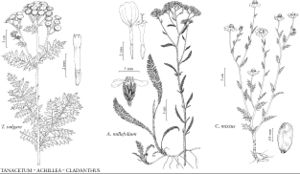Cladanthus
Bull. Sci. Soc. Philom. Paris 1816: 199. 1816.
| Taxon | Illustrator ⠉ | |
|---|---|---|
 | Tanacetum vulgare Achillea millefolium Cladanthus mixtus | Yevonn Wilson-Ramsey Linny Heagy Yevonn Wilson-Ramsey |
Annuals [perennials, subshrubs], 10–60+ cm (usually aromatic). Stems usually 1, usually erect [prostrate], branched [immediately proximal to sessile, terminal heads], puberulent or villous to arachnose (hairs basifixed), glabrescent. Leaves mostly cauline; alternate; petiolate (proximal) or sessile (distal); blades obovate or spatulate to oblong or linear, 1–2 (–3) -pinnately lobed (ultimate lobes ± linear to filiform), ultimate margins entire or dentate, faces villous to arachnose, glabrescent. Heads radiate, borne singly or in lax, corymbiform arrays. Involucres hemispheric or broader, 5–8 [–12+] mm diam. Phyllaries persistent, 16–24+ in 2–3+ series, lance-linear or lanceolate to oblong or obovate, subequal, margins and apices (hyaline) scarious (apices ± dilated, rounded, abaxial faces ± villous or arachnose, glabrescent). Receptacles hemispheric to narrowly columnar or conic, paleate; paleae ± folded (carinate, each with central, redbrown resin duct). Ray-florets 12–18+, neuter or styliferous and sterile; corollas orange, yellow, or white with yellow bases, laminae ± oblong (spreading to reflexed, ± marcescent). Disc-florets 40–150 [–200+], bisexual, fertile; corollas orange or yellow, tubes ± cylindric (bases saccate, each obliquely spurred, adaxially clasping distal 0.5+ of cypsela), throats campanulate to funnelform, lobes 5, deltate (apices minutely crested or dilated). Cypselae ± obovoid (apices oblique), weakly flattened (stylopodia sublateral), ribs or nerves (weak): 2 lateral, 1 adaxial, faces finely striate, glabrous [hairy] (pericarps with myxogenic cells in longitudinal rows, without resin sacs); pappi 0. x = 9.
Distribution
Introduced; s Europe, sw Asia, n Africa, also in South America, elsewhere in Old World
Discussion
Species ca. 5 (1 in the flora).
Selected References
Lower Taxa
"broader" is not a number.